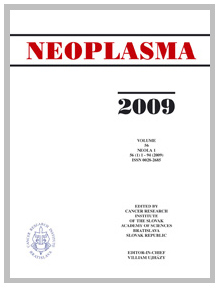Journal info
|
||
Select Journal
Journals
Bratislava Medical Journal Ekologia - Ecology Endocrine Regulations General Physiology and Biophysics Neoplasma 2025 Ahead of print 2024 2023 2022 2021 2020 2019 2018 2016 2017 2015 2014 2013 2012 2011 2010 2009 2008 2007 2006 2005 2004 2003 Acta Virologica Studia Psychologica Cardiology Letters Psychológia a patopsych. dieťaťa Kovove Materialy-Metallic Materials Slovenská hudba 2025Webshop Cart
Your Cart is currently empty.
Info: Your browser does not accept cookies. To put products into your cart and purchase them you need to enable cookies.
Neoplasma Vol.63, No.3, p.427-434,2016 |
||
| Title: Prediction of additional lymph node involvement in breast cancer patients with positive sentinel lymph nodes | ||
| Author: K. POHLODEK, S. BOZIKOVA, I. MECIAROVA, V. MUCHA, M. BARTOVA, F. ONDRIAS | ||
| Abstract: Axillary lymph node dissection (ALND) has traditionally been the principal method for evaluating axillary lymph node status in breast cancer patients. In the past decades sentinel lymph nodes biopsy after lymphatic mapping has been used to stage the disease. The majority of sentinel lymph nodes (SLN) positive patients do not have additional metastases in non-sentinel nodes (non-SLN) after additional ALND. These patients are exposed to the morbidity of ALND without any benefit from additional axillary clearence. In the present study we would like to asses the criteria for selecting those patients, who have high risk for non-SLN metastases in the axilla in cases of positive SLN. In this retrospective analysis, clinical and pathologic data from 163 patients who underwent SLN biopsy followed by ALND were collected. Following clinical and pathological characteristics were analyzed to predict the likehood of non-SLN metastases: age, staging, histologic type and grading of the tumors, hormonal receptor status, HER-2 receptor status and Ki-67 protein, angioinvasion, metastases in SLN and non-SLN. Relative frequencies of individual characteristics between sample groups were statistically tested by Chi-square test at significance level p=0.5, when sample sizes in groups were small (≤5) by Fisher´s exact test. Metastasis in SLN were present in 67 (41%) of patients, 48 patients (29,4%) had metastasis also in non-SLN. The ratio between non-SLN positive / non-SLN negative lymph nodes in patients with positive SLN increases with the stage of the disease, the difference between values for the pT1c and pT2 stadium was statistically significant (p = 0.0296). The same applies to grading, but the differences were not significant (p>0.05). We could not find significant differences for angioinvasion of the tumor, probably for small number of patients with angioinvasion (p>0.05). Only the stage of the tumor was shown to be significant in predicting the metastasis in non-SLN in our group of breast cancer patients with positive SLN Nearly 80% of the patients of 70 years and older displayed no benefit from axillary staging, because of negative SLN as well as non-SLN, although thanks to the small sample size this was not a statistically significant result. Furthermore, current recommendations for axillary staging in breast cancer patients are discussed. |
||
| Keywords: breast cancer, surgery, sentinel lymph node biopsy, axillary dissection | ||
| Published online: 16-May-2016 | ||
| Year: 2016, Volume: 63, Issue: 3 | Page From: 427, Page To: 434 | |
| doi:10.4149/312_150922N497 |
||
|
|
 download file download file |
|

